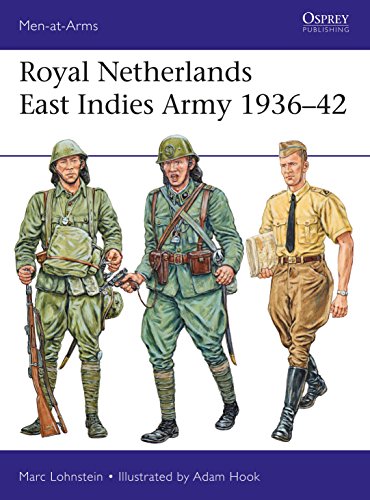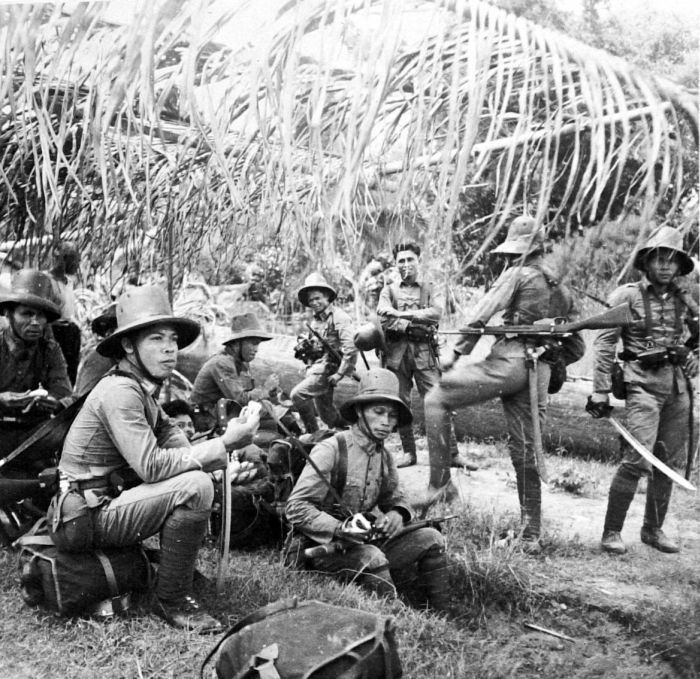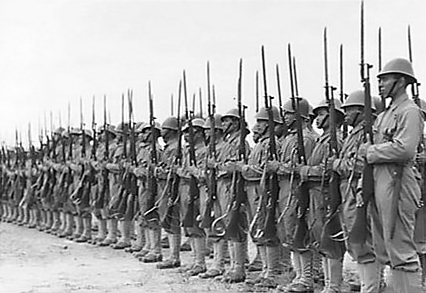 This is a book from Osprey that I have waited for a long time. I think I first became aware of the Netherlands East Indies in WW2 in the novel Tarzan and the Foreign Legion. In that novel, Col. John Clayton, Lord Greystoke is shot down while an observer on an American heavy bomber on the island of Sumatra. He reverts to Tarzan and kills many Japanese.
This is a book from Osprey that I have waited for a long time. I think I first became aware of the Netherlands East Indies in WW2 in the novel Tarzan and the Foreign Legion. In that novel, Col. John Clayton, Lord Greystoke is shot down while an observer on an American heavy bomber on the island of Sumatra. He reverts to Tarzan and kills many Japanese.
Burroughs had some Dutch guerrillas operating on the island that link up with Tarzan. Later I read H. P. Wilmot’s Empires in the Balance. This was the first information I ever read on the Royal Netherlands Indies Army (KNIL). From there, I discovered the old geocities Netherlands East Indies in WW2 website and used to participate on the forum there. There had been talk 18 years ago of contacting Osprey to get a booklet on the KNIL done.
Finally, we have a book devoted to the KNIL 1936-1942. Marc Lohnstein is the author, Adam Hook the illustrator. Lonnstein is the assistant curator at the Royal Home for Retired Military Personnel & Museum Bronbeek in the Netherlands. He translated information from Dutch not available in English before.
H. P. Wilmot pointed out that the Netherlands had the third largest colonial empire at the outset of World War 2. The Netherlands East Indies, modern day Indonesia was probably the most profitable colony in the world. The N.E.I. produced 29% of the world’s rubber, 20% tin, 97% of quinine. It also produced a large amount of oil including 13% of Japan’s imports.
The KNIL was created in 1814 and lasted until Indonesian independence. It was the organization that expanded Dutch authority throughout the East Indies suppressing piracy and native revolts. It was a classic colonial army meant to keep order, not to fight European battles.
The organization was 38,500 strong, 20% European, 43% Javanese. 25% were natives from Ambon and Manado from northern Celebes as they were Christian and not Moslem.
Lohnstein goes into the organization of the KNIL and the history of its attempted modernization program starting in 1936. Unfortunately, the start of  WW2 ended shipment of equipment on order from the U.K., France, and Austria.
WW2 ended shipment of equipment on order from the U.K., France, and Austria.
The KNIL was weak on logistics and staff training for its officers. Holland avoided WW1. As a result, you did not have officers with battlefield experience as in the British, Australian, and American armies. An Australian general concluded the KNIL “should be regarded more as well-equipped Home Guards than an Army capable of undertaking operations in the field.”
A Japanese officer said when commanding the invasion of Ambon, that Dutchmen did not worry him, it was Australians who worried him.
The Dutch had a total of 122,600 professionals, reservists, militia, home guard, and auxiliaries in the N.E.I. A few did escape (mostly from Timor) and fought later with the Australians at Tarakan Island.
This Osprey booklet has a brief overview of sequence of the Japanese campaign that overran the Netherlands East Indies. You can get more detail on the “Breaking of the Dutch” as H. P. Wilmot put it.
The Dutch attempted to prepare for war with Japan. Makes me think if the Anglo-Indian Army had held the Jitra line in Malaya, that would have secured the western portion of “the Malay Barrier.” The Japanese moved up their schedule for conquest of the N.E.I by a month due to the quick occupation of Manila and Luzon. The Philippine Army was still in the process of mobilization when war broke out. The mobilization order has sat on Roosevelt’s desk since late 1940. He did not order mobilization until the end of July 1941. With another eight months of organization and training, not to mention some of the Lend Lease equipment he was hell bent on giving to Stalin, the Philippine Army might have given a better showing. That might have slowed the Japanese juggernaut delaying their conquest by a month or two.

AUSTRALIA. 1943. A REGIMENT OF NETHERLANDS EAST INDIES FORCES AT THE ”PRESENT” DURING AN INVESTITURE OF DECORATIONS ON MEMBERS OF THE N.E.I. FORCES BY LIEUTENANT COLONEL N.L.W. VAN STRATEN, OFFICER COMMANDING N.E.I. ARMY FORCES IN AUSTRALIA.
Two Australian infantry divisions and a British armored brigade were on the way when Java fell. Roosevelt seemed convinced the Wehrmacht was going to be landing in the Caribbean at any time. The island of Trinidad ended up with 15,000 U.S. Army personnel alone. What if Adm. Kimmel allowed a good portion of the Pacific Fleet to be transferred to the Atlantic? In our timeline, he protested and got his way. Then what if the midget submarine attack on Pearl Harbor before the air attack and the radar warning was heeded? You have the Japanese losing maybe 130 planes instead of 30. You also have a fleet not completely crippled. Troops meant for the Caribbean are rushed to hold Rabaul in New Britain, Ambon, Kendari and Makassar in Celebes before the Japanese get there. The Dutch had built nice airfields all over the N.E.I. in anticipation of war with Japan. Unfortunately, they seized the airfield in Kendari which was used to bomb Java daily and destroy Allied air strength. Ditto with airfields on Borneo.
You could have had a situation of Australians in Borneo, Americans in Celebes backing up Dutch forces and grinding up Japanese troops like later happened at Guadalcanal. The Japanese used 11 divisions for their push south. The 38th Division that took Hong Kong was then used to take Timor and finally chewed up at Guadalcanal. The Imperial Guards used in Malaya and Singapore then took northern Sumatra. The 48th Division first invaded Luzon in the Philippines and then Java. The Japanese were operating on a very thin margin.
Seems all the alternative histories have Japan even more victorious. It all could have gone very wrong much earlier. Would be interesting to have a time line where the KNIL plays a major part in defeating Japan that gets no farther than Borneo and Celebes.
Morgan – I dove into the Nafziger OOB files for 1941 and 1942 and found some complimentary information.
For those that have downloaded the zip files (info in the WW Nafziger post) the next comments will contain two OOBs from 1942. Start searching files with the third position having the letter “P” for Pacific. Example: 942PCAF = 1942 Pacific, as for C have no idea, and AF should be unique identifiers for the file name.
Most information available is on the Japanese but did find one for the Dutch (file 942PCAF.pdf)
Dutch Army on Java March 1942
WEST JAVA COMMAND
1st Infantry Division 1st Infantry Brigade 2nd Infantry Brigade 1 Artillery Regiment 1st Motorized Cavalry Regiment (2 sqns)
Blackforce 2/3 Australian Machine Gun Battalion 2/2 Australian Pioneer Battalion 2/6 Field Company RAE light tank sqn, 3rd Hussar Regiment 131st U.S. Fd Artillery Regiment (less one bty)
CENTRAL JAVA COMMAND 4th Infantry Brigade 2nd Motorized Cavalry Regiment (one sqn) 12 x 75mm field artillery pieces “Zuid” Reserve Group (battalion strength) Composite garrison unit (battalion strength) at Tjilatjap
EASTERN JAVA COMMANDs
3rd Infantry Division 6th Infantry Brigade 2nd Artillery Regiment (inc. one bty, 131st U.S. Field Artillery Regiment) 3rd Motorized Cavalry Regiment (one sqn) Dutch Marine bn (composite) at Surabaya
Barisan Corps Madoera Is detachment – composite unit of about three bns Two Infantry Comapnies 21st Light Anti-Aircraft Regiment (British) 77th Heavy Anti-Aircraft Regiment (British)
Note: “Scattered through Java were six Landstorm garrison units of doubtful quality”
Greene, Jack. WAR AT SEA: PEARL HARBOR TO MIDWAY. New York : Gallery Books, 1988.
(C) G.F.Nafziger 1996 –
942PCAK.pdf
Japanese 2nd Division Invasion of Java 1 March 1942
2nd Division Nasu Detachment: Colonel Nasu HQ, 2nd Infantry Group 16th Infantry Regiment (- 1 battalion) 1 tank company 1 rapid firing gun company 2nd Reconnaissance Regiment 1 bicycle unit 1 field artillery battalion 1 anti-aircraft company Fukushima Detachment: Colonel Fukushima 4th Infantry Regiment (- 1 battalion) 1 rapid firing gun battalion (-2 companies) 1 field artilelry battalion 1 anti-aircraft battalion (-2 companies) Sato Detachment: Colonel Sato 29th Infantry Regiment 2nd Tank Regiment (-3 cos) 1 rapid firing gun company 2nd Engineering Regiment (- 2 companies) the unknown unit occupying Pangean Island Artillery: Colonel Ishizaki 2nd Field Artillery Regiment (- 2 1/2 battalions) 1 heavy field artillery regiment (-1 company) Engineering Unit: Colonel Oda 1st Independent Engineering Regiment (- detachments) 4th Independent Engineering Company one independent automobile platoon two river crossing construction companies (- detachment) Air Defense Unit: 16th Anti-Aircraft Regiment (- detachments)
Note: The division was to land at Pojanegara, with a detachment land- ing at Merak. It was to capture a crossing over the river at Rang- kasbitoeng. From there it was to move on Serang, then advance downt he Serang-Tangerang-Batavia roads towards Batavia. After Batavia, it was to move on Bandon, through Poerwakarta and Suban, then on Ban- don, with elements moving on Iljandjoer area, and capture Bandon in conjunction with Shoji detachment. After these operations, it was to capture all of Java in cooperation with the 48th Division.
2
Shoji Detachment: Colonel Shoji 230th Infantry Regiment 1 tank company 1 machine gun battalion (-2 companies) 1 mountain gun batalion (-1 company) 1 engineer company (-2 platoons) 1 anti-aircraft company
Japanese Studies in World War II, Monograph No. 69, Java-Sumatra Area Air Operations Record, December 1941- March 1942, Prepared for Mili- tary History Section, HQ, Army Forces Far East.
Copyright GFN 2004
Of course, I look at dutcheastindies.webs.com after I post the OOBs and that site definitely has a bounty of OOB and campaign information!
Not sure holding the line in Malaya was ever in the cards. In Malaya, the Commonwealth actually had superior forces but just like 1940 France, their opponents bought innovative tactics and higher morale. Once they met up with the Australians, the Japanese took their first serious losses but still outflanked their opponents and pushed them back.
Interesting to think about how effective U.S. troops and Australians helping the Dutch would have been. I have no idea if the U.S. troops were up for the fight at this point in time but the campaign would not be decided on land, but at sea and in the air.
The Allies outnumbered the Japanese on Java. The Australians and
Texas National Guard units wanted to keep fighting. The Dutch actually
turned their machine guns on a company of Texans at an airfield who saw no
fighting.
They would have been better to make their fight on other islands before
the Japanese closed in on Java. Java by reason of geography would be a
bitch to defend.
It is an area of fascination for me. Like I wrote, things could have gone
wrong for the Japanese early on. If the U.S. planes had not been caught on
the ground at Clark Airfield December 8, had our torpedoes worked, had the
Philippine Army had another 4-8 months of training, an expanded Philippine
Scouts (24,000 instead of 12,000), British concentration of battalions at
the Jitra line instead of scattered all over Malaya. Makes for interesting
counterfactuals.